Key takeaways:
- Film critique enhances understanding and appreciation of cinema by fostering personal engagement with themes and societal issues.
- Streaming provides convenience and a personalized viewing experience, allowing for exploration of diverse narratives and independent films.
- Effective critique involves analyzing story structure, character development, and technical elements like cinematography and sound design.
- Discussing films with others can deepen insights and expand interpretations, enriching the overall viewing experience.
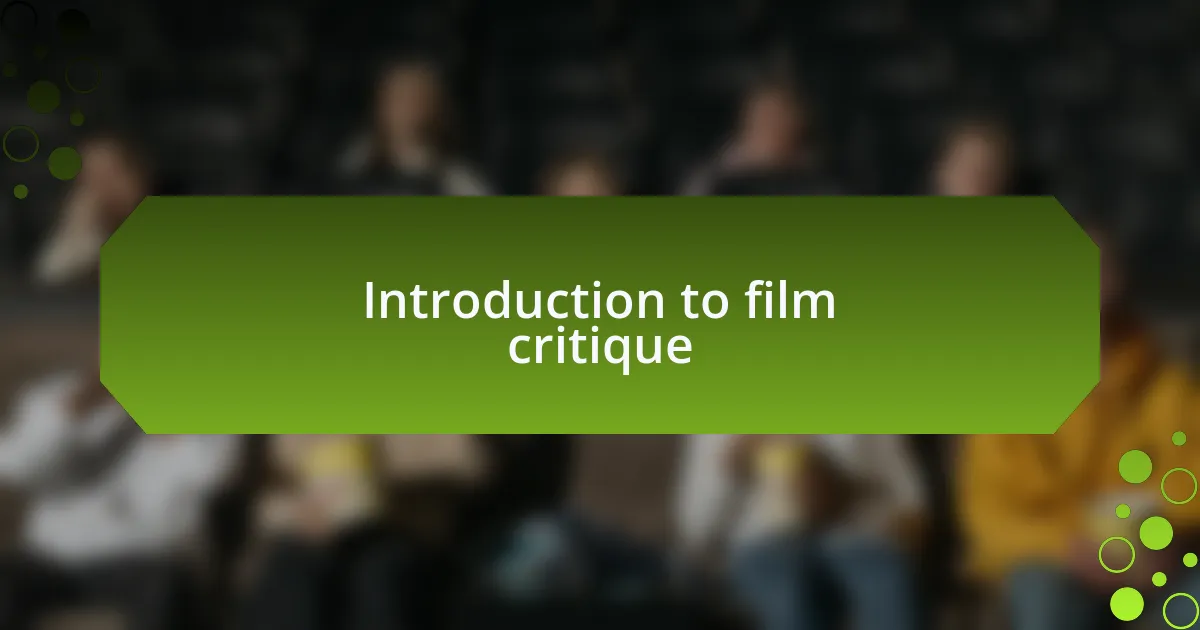
Introduction to film critique
Film critique is an essential tool for understanding and appreciating cinema beyond mere entertainment. I often find myself reflecting on why a particular film resonates with me emotionally or intellectually—what makes it click? This kind of analysis not only deepens my enjoyment but also enriches the viewing experience for others.
As I dive into discussions about various films, I remember early experiences where a single line or scene stuck with me long after the credits rolled. Have you ever wondered why a specific moment in a movie had such a profound impact on you? For me, it’s in those instances that I start to dissect the cinematography, the score, and the performances, realizing that every element plays a crucial role in storytelling.
Critique isn’t about merely listing what worked or didn’t; it’s about engaging with the film on a personal level, exploring its themes, and identifying how it connects—or fails to connect—with broader societal issues. I think back to films that sparked important conversations among friends, changing how we viewed certain topics. Isn’t it fascinating how a well-crafted narrative can shape our perspectives?
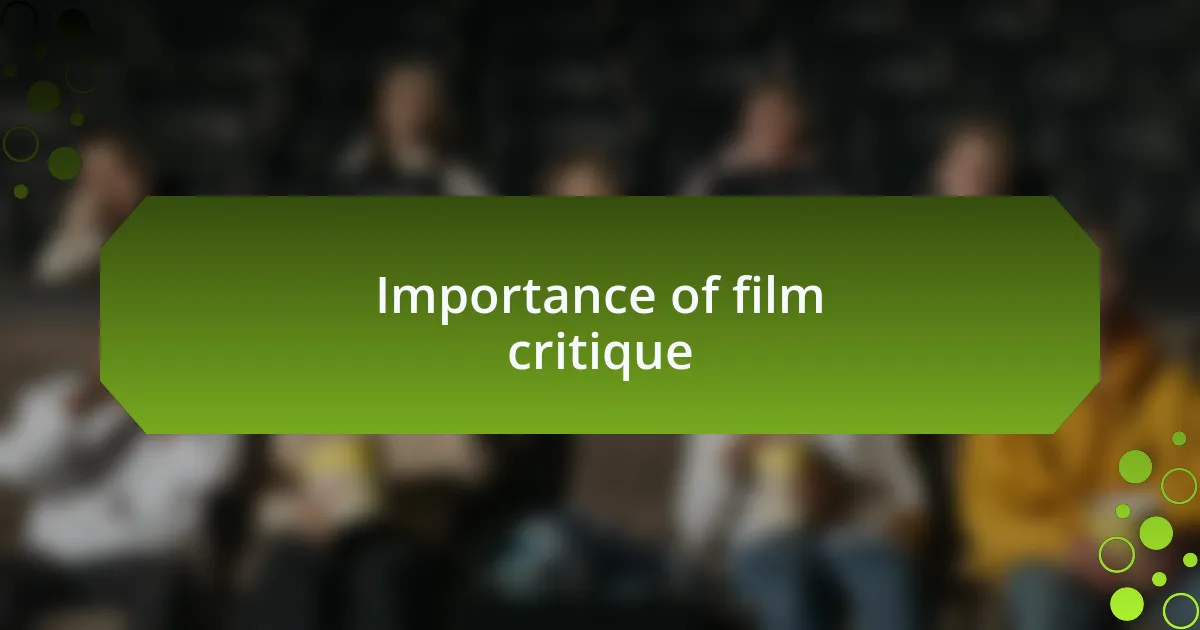
Importance of film critique
Film critique serves as a bridge between viewers and the artists behind the lens, providing insights that can transform a passive viewing into a rich conversation. I recall dissecting the emotional weight of a character’s journey in a recent film with friends, each of us pulling different meanings from the same scenes. Doesn’t it invigorate the experience when we realize that films can reflect our own life stories or societal struggles?
Engaging with film critiques has sharpened my ability to analyze not just movies, but the world around me. For instance, after critically exploring a documentary on climate change, I found myself more motivated to participate in environmental activism. Don’t you think films have a unique power to inspire us to take action when they connect art to real-world issues?
Moreover, the process of critique fosters a deeper appreciation for the craftsmanship involved in filmmaking. I remember feeling awe during a conversation where we unpacked the genius of a director’s vision in a visually stunning film. How often do we overlook the layers of thought that go into every shot, every sound? This kind of examination enriches our understanding and can lead to a lasting love for the art itself.
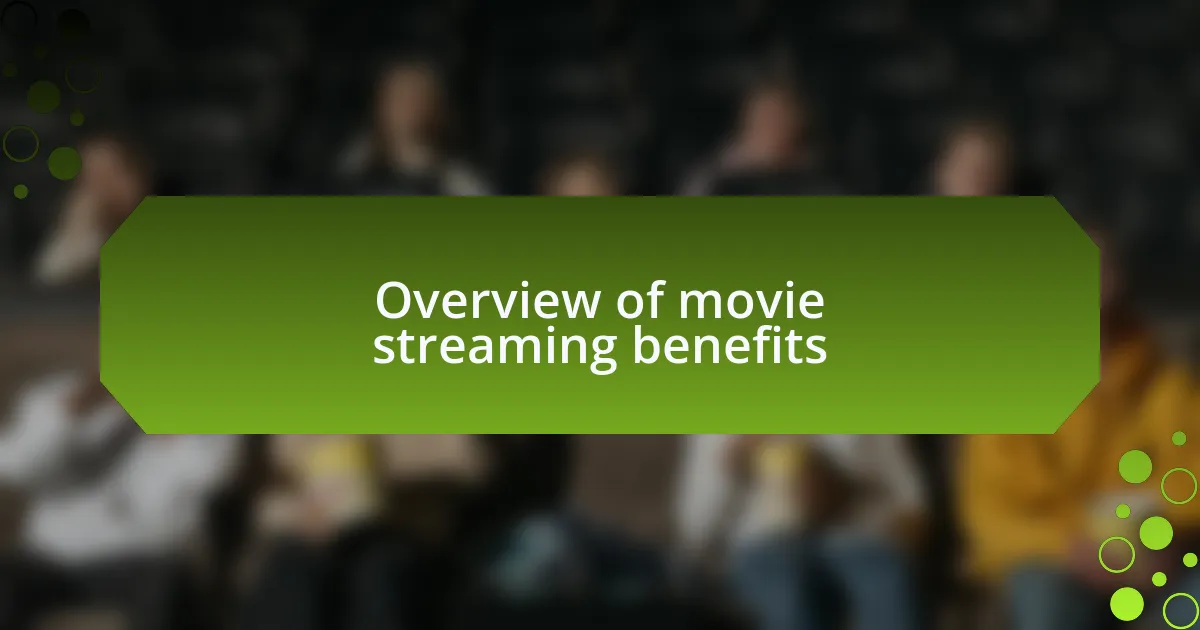
Overview of movie streaming benefits
Movie streaming offers unparalleled convenience, allowing viewers to access a diverse range of films from the comfort of their homes. I still remember the excitement of discovering a classic film that sparked my passion for cinema while lounging on my couch. Isn’t it amazing how just a few clicks can transport us to different eras and cultures?
Additionally, the ability to personalize viewing experiences through streaming platforms can significantly enhance our film enjoyment. I often find myself curating a list of films that resonate with my mood or interests, making every movie night feel uniquely tailored. How many times have you felt a deeper connection to a film simply because it was suggested based on your previous choices?
Moreover, streaming services frequently provide an avenue for discovering independent and foreign films that might not make it to traditional theaters. For example, stumbling upon a lesser-known gem from an up-and-coming director truly opened my eyes to fresh narratives and perspectives. Isn’t it exhilarating to find hidden treasures that you never would have encountered otherwise?
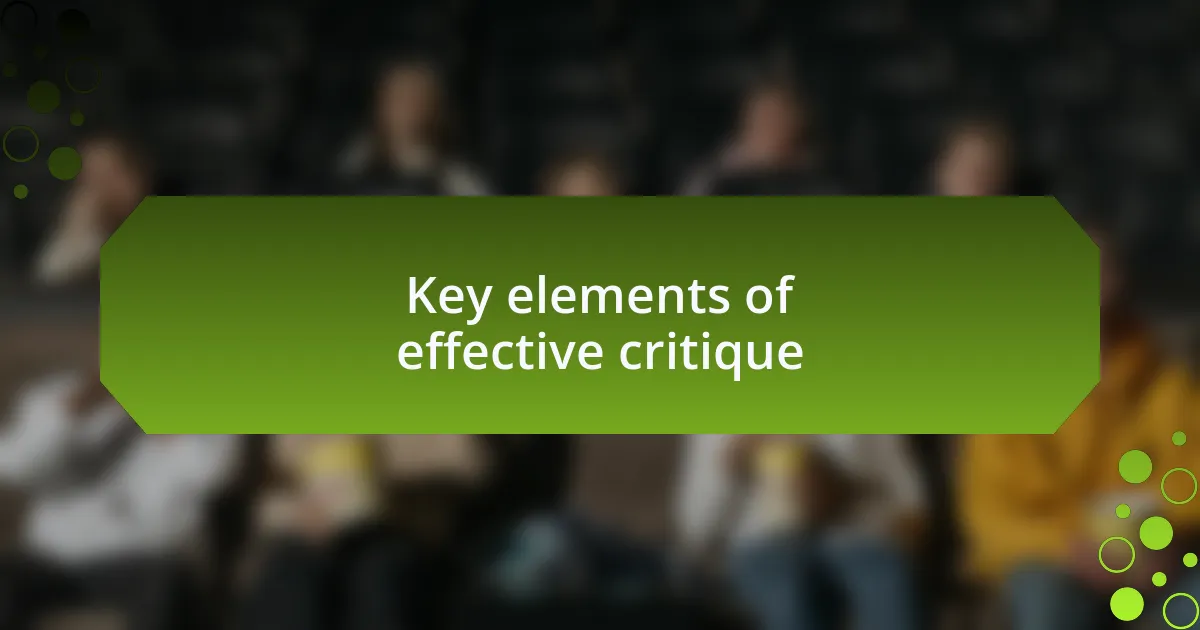
Key elements of effective critique
When critiquing a film, it’s essential to consider not only the story but also how effectively it is told. I always find myself asking, “Did the narrative engage me?” The pacing and structure of the plot can make or break a film, and attentive analysis of these elements can reveal deeper insights into the filmmaker’s intentions.
Another key element is character development. I’ve watched films where I felt an emotional connection to the characters, while others left me feeling indifferent. Reflecting on how well the characters evolve throughout the film can add layers to your critique. What drives them? How do their interactions shape the story? These questions lead to a richer understanding of the film’s themes.
Cinematography and sound design are often overlooked, yet they play a critical role in setting the mood. I remember being captivated by a film where the subtle use of sound created an almost palpable tension. How often do we notice how the visuals enhance the story? Paying attention to these technical aspects can elevate a critique from simple observation to a compelling analysis.
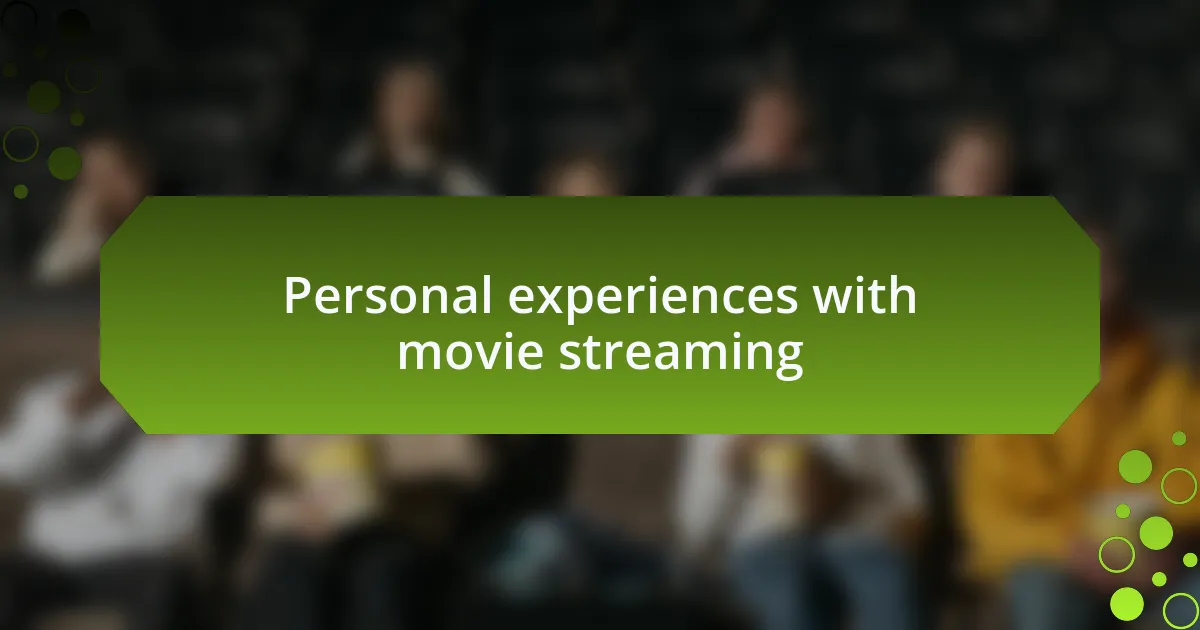
Personal experiences with movie streaming
Streamlining my movie streaming experience has been transformative. I recall one late-night binge session where I stumbled upon a hidden gem that resonated deeply with me. The story was simple but powerful, and I found myself emotionally invested, laughing and crying as the characters navigated their challenges. It made me realize that the right film can create a connection, even when streaming from the comfort of my couch.
Navigating different platforms has its ups and downs, which I’ve personally experienced. One time, I tried to watch a much-anticipated film, only to find it buried under a sea of content that made it hard to discover. It struck me how crucial it is to have a user-friendly interface. After all, what’s the point of having a vast library if you can’t easily find the stories that spark your interest?
The beauty of movie streaming lies in the ability to curate my own viewing experience. There have been moments when I’ve hosted virtual watch parties, sharing my thoughts in real-time with friends. I love how these interactions allow for lively discussions that deepen my understanding of the film. Isn’t it fascinating how a collective viewing experience can enhance our emotional reactions and reflections? It certainly has for me.
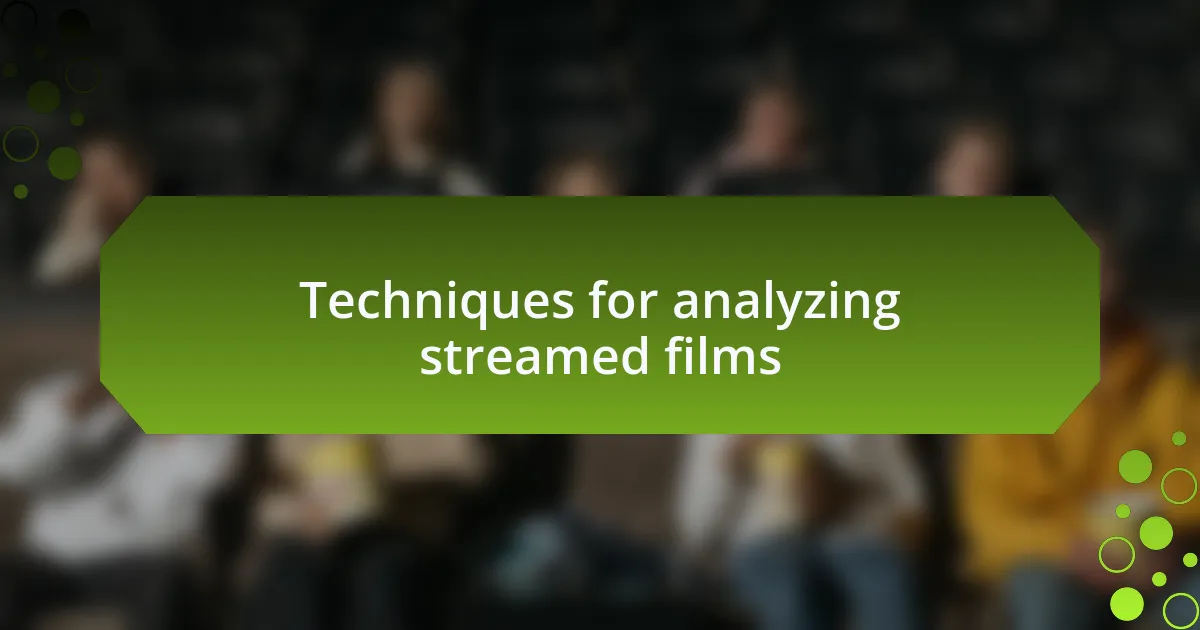
Techniques for analyzing streamed films
To truly analyze streamed films, I find it essential to immerse myself in the visual and audio elements. Recently, while watching a suspenseful thriller, I couldn’t help but notice how the sound design heightened my anxiety, making my heart race before the big reveal. Isn’t it intriguing how music and sound can shape our perception of a scene?
Another technique I often employ is to pause and reflect on key scenes. There was a moment in a recent film where the protagonist made a pivotal choice. I hit pause, marveled at the actor’s expression, and wondered how different my interpretation might be if the scene had been shot differently. This practice encourages me to engage deeply with the narrative and consider the director’s choices.
Finally, discussing films with friends after watching has proven invaluable. During a recent group chat about a romantic drama, we dissected characters’ motivations and plot twists that we initially missed. It’s interesting how fresh perspectives can reveal layers of a story I might overlook on my own. How often do we realize that our understanding of a film can expand through dialogue? It continually surprises me how these conversations breathe new life into the viewing experience.
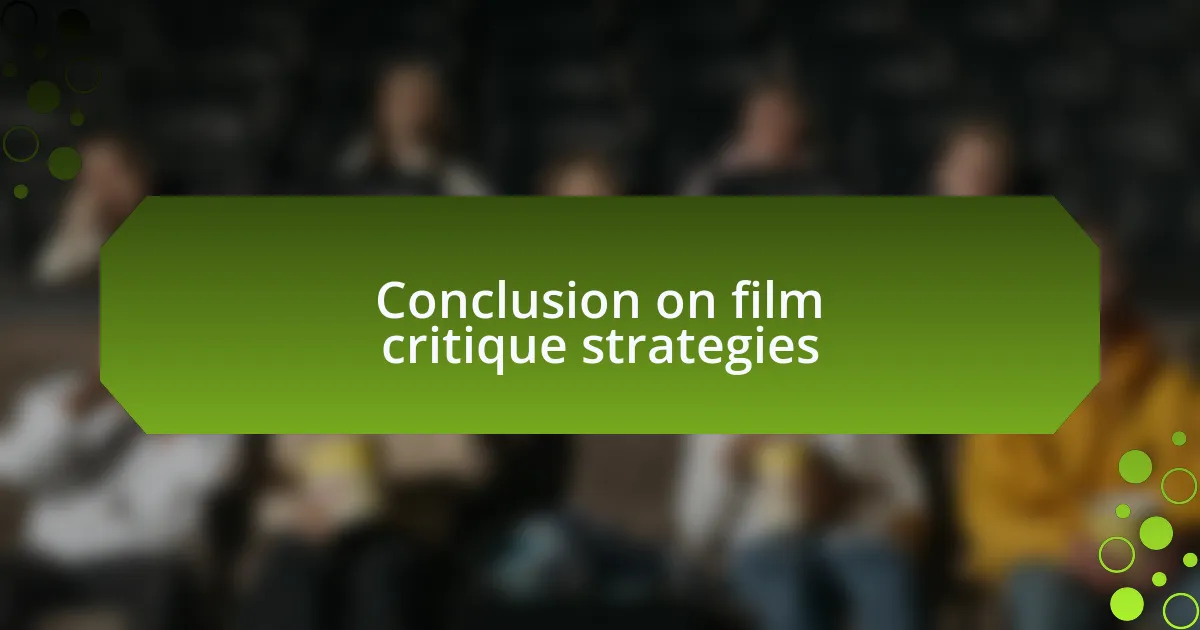
Conclusion on film critique strategies
When reflecting on the film critique strategies I’ve gathered over time, I realize it’s about finding a personal approach that resonates. For instance, sharing my thoughts on a film immediately after watching it often brings clarity. I had a moment after seeing a biopic where I spilled my thoughts to my spouse, and certain themes came alive that I hadn’t fully appreciated during the viewing. Isn’t it fascinating how speaking out loud can crystallize our reactions?
Another noteworthy strategy is revisiting films after some time has passed. I once watched a classic I loved in my youth, and coming back to it years later brought an entirely new perspective. My understanding had matured, and I found layers that resonated with my current experiences. How often can a film serve as a mirror reflecting the evolution of our own lives?
Ultimately, it’s about cultivating a flexible mindset when engaging with cinema. I often remind myself that no single viewing can encapsulate a film’s essence fully. I keep a journal to jot down initial impressions versus later reflections, and this practice has shown me how films can grow alongside our own experiences. Have you thought about how your views shift over time? Embracing this dynamic process makes the art of film critique not only engaging but deeply personal.